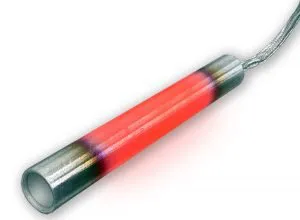Cartridge Heaters: Heating Liquids
In this article, we discuss heating liquids and the wattage requirements for heating various materials. If used and controlled properly, cartridge heaters can provide a long-term solution for many conductive process heating applications.
Make sure that the heater will always be surrounded by the liquid you are heating. The liquid acts as the heat sink and it is required to keep the heater at a safe operating temperature. Be sure to consider a worst-case scenario where the liquid could drop as low as it can go, even in the case of a leak in your tank. Without the liquid around your heater to help pull the heat away, the heater will be exposed to air and run hotter. That excess temperature may decrease the life of your heater depending on the operation temperature.
Have safety precautions in place. TUTCO recommends a high-limit thermostat to turn off the heater in case the liquid level gets too low, for example. Using a closed loop control system with the high limit thermostat will help monitor and control the voltage to the heater.
Keep liquid away from the leads or screws of the heater. Lead connections are electrically live and must not be submerged to prevent electrical hazards. Please contact the factory for proper terminal connections for liquid applications.
If using a temperature controller with a thermocouple (or other temperature sensing device), make sure that the sensor’s location in the tank is carefully considered. If the sensor is too far from the heater, it may never turn off. If the sensor is too close, the heater may cycle too frequently. If the liquid level drops allowing the sensor to be exposed to air, that would be bad too.
Correct Heater Wattage
Heater wattage can vary depending on the material being heated. Here are a few quick rules of thumb for heating different mate- rials (these are rough numbers):
- For Water in a tank – Wattage Required = Gallons x Temperature Increase (in °F) x 3.08 / Hours to get to temperature
- For Flowing Water – Wattage Required = Gallons Per Minute x Temperature Increase (in °F) x 0.16
- For Oil in a Tank – Wattage Required = Gallons x Temperature Increase (in °F) x 1.25 / Hours to get to temperature
- For Flowing Oil – Wattage Required = Gallons Per Minute x Temperature Increase (in °F) x 0.40
After determining the wattage requirement, try to hold yourself to that limit. Excess wattage may not be pulled away by the application quickly, resulting in an increase in heater temperature. That increase in temperature stresses the internal components of the heater causing them to oxide faster (than they normally would) and reduces the dielectric strength (electrical insulative properties) inside the heater.
 Cartridge heaters have a watt density limit, meaning there is a maximum wattage you can get out of a heater based on its surface area. The smaller the heater and the larger the heat sink, the more you can bend this rule. For large heaters, over 1/2” in diameter and longer than half a foot in length, that rule must be more strictly adhered to.
Cartridge heaters have a watt density limit, meaning there is a maximum wattage you can get out of a heater based on its surface area. The smaller the heater and the larger the heat sink, the more you can bend this rule. For large heaters, over 1/2” in diameter and longer than half a foot in length, that rule must be more strictly adhered to.
Larger surface areas can put out more wattage and the wattage must go somewhere. Unless the heat sink is sufficiently large enough for the application, the heat won’t have anywhere to go, and the heater temperature will increase. Reminder, a hotter heater the shorter the life span due to excessive internal oxidation and dielectric issues.
